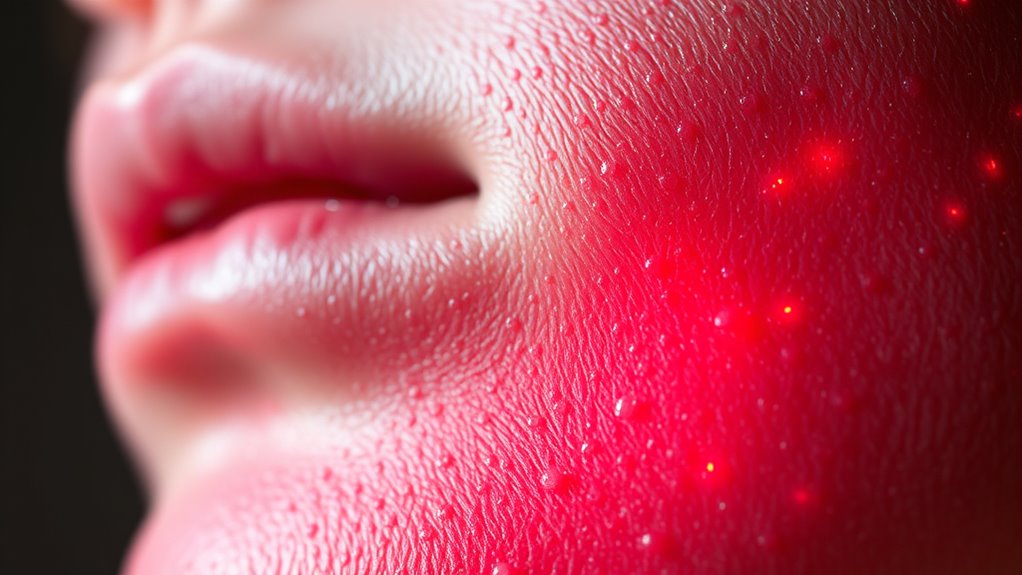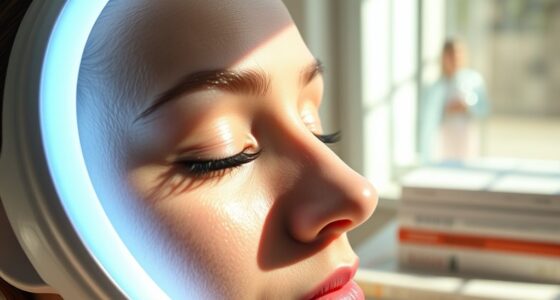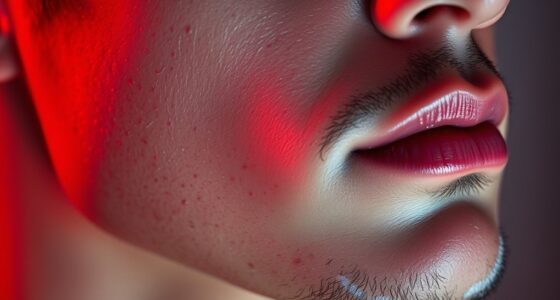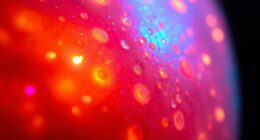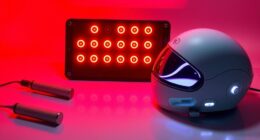Using red light therapy after exfoliation is generally safe if you wait at least 24 hours and guarantee your skin isn’t red, inflamed, or sensitive. Exfoliating removes dead skin, which can make your skin more vulnerable, so giving it time to recover minimizes risks. Start with shorter sessions and monitor how your skin reacts. To protect your skin and maximize benefits, make sure to follow proper guidelines—more helpful tips await if you keep exploring.
Key Takeaways
- Red light therapy is generally safe after exfoliation if skin is fully recovered and free of irritation.
- Wait at least 24 hours post-exfoliation before using red light to reduce risk of sensitivity.
- Assess skin for redness or irritation before treatment; avoid applying on sensitive, freshly exfoliated skin.
- Starting with shorter, lower-intensity sessions minimizes potential discomfort or adverse reactions.
- Consult a dermatologist if unsure about skin condition or if experiencing abnormal redness or irritation.
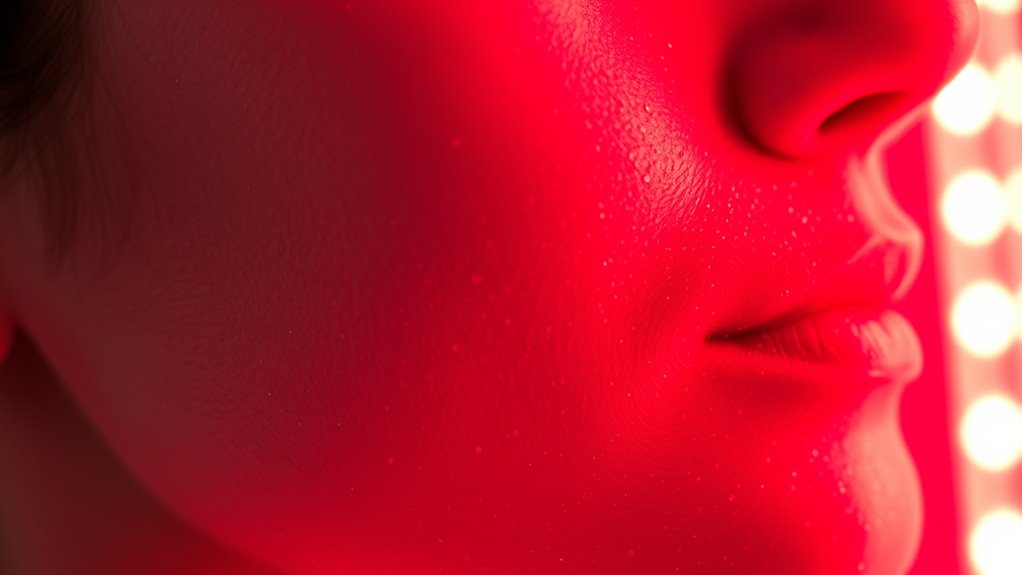
Have you ever wondered whether red light therapy is safe to use after exfoliating? It’s a common question, especially if you’re someone who invests time in skincare routines and wants to maximize their benefits. The short answer is that, generally, red light therapy is considered safe post-exfoliation, but there are important factors to keep in mind to avoid potential irritation or adverse effects. Understanding how your skin reacts and the timing of treatments can make all the difference.
Red light therapy is generally safe after exfoliating, but timing and skin sensitivity matter.
When you exfoliate, whether using a chemical peel, scrub, or enzymatic treatment, you’re intentionally removing the top layer of dead skin cells. This process can temporarily leave your skin more sensitive and vulnerable. Red light therapy works by penetrating the skin to stimulate cellular activity, promote healing, and reduce inflammation. Because it encourages blood flow and cellular regeneration, many see it as a beneficial follow-up to exfoliation. However, if your skin is freshly exfoliated, the surface might be more prone to irritation from external stimuli, including light therapy.
If you plan to use red light therapy right after exfoliating, it’s essential to assess how your skin feels. If it’s red, inflamed, or irritated, it’s best to wait until the redness subsides. Applying red light therapy on sensitive, freshly exfoliated skin can sometimes cause discomfort or exacerbate irritation. You might notice a burning or stinging sensation, or the skin could become more inflamed. To minimize these risks, many skincare professionals recommend waiting at least 24 hours after exfoliation before using red light therapy, especially if your skin is particularly sensitive or reactive.
Another critical aspect is the intensity and duration of your red light sessions. If you’re using a device at home, start with shorter treatments at lower intensities. This cautious approach allows your skin to adapt and helps you gauge how it responds after exfoliating. If you experience any discomfort or unusual redness during the session, it’s wise to stop and give your skin more time to recover before trying again.
To optimize safety, consider applying a soothing serum or moisturizer before the therapy. This can create a protective barrier and reduce the likelihood of irritation. Additionally, always follow the manufacturer’s guidelines for your specific device and consult with a dermatologist if you’re unsure about your skin’s condition or if you have underlying skin issues. With proper precautions, red light therapy can be a safe and effective part of your skincare routine, even after exfoliating.
Furthermore, understanding the benefits of skin regeneration promoted by red light therapy can help you make informed decisions about its timing and application.
Frequently Asked Questions
Can Red Light Therapy Cause Skin Irritation After Exfoliation?
Red light therapy can cause skin irritation after exfoliation if your skin is sensitive or already irritated. Exfoliating removes dead skin cells, making your skin more vulnerable to irritation from light therapy. To avoid issues, wait at least 24-48 hours after exfoliating before using red light therapy. Always do a patch test first, and if you notice redness or discomfort, stop and consult a dermatologist.
How Long Should I Wait to Use Red Light After Exfoliating?
You should wait at least 24 hours after exfoliating before using red light therapy. Exfoliation can leave your skin sensitive and more prone to irritation, so giving it time to recover helps prevent adverse reactions. If your skin feels calm and not irritated, you can proceed. Always listen to your skin’s signals and consider consulting a dermatologist if you’re unsure about the timing or your skin’s condition.
Is Red Light Therapy Safe for Sensitive or Broken Skin?
Red light therapy is generally safe for sensitive or broken skin, but you should proceed with caution. You might worry about irritation, but gentle exposure can promote healing and reduce inflammation. Just make certain your skin is clean, avoid overexposing fragile areas, and consult a dermatologist if you’re unsure. Using a lower intensity setting initially helps your skin adapt, making the treatment safer and more effective for sensitive conditions.
Does Exfoliation Increase Red Light Absorption?
Yes, exfoliation can increase red light absorption because it removes dead skin cells, revealing fresher, more receptive skin layers. When you exfoliate, your skin becomes more permeable, allowing the red light to penetrate deeper and potentially boost its effectiveness. However, be cautious if your skin is sensitive or irritated; over-exfoliating might cause discomfort or damage, so always listen to your skin’s response and avoid overdoing it.
Are There Specific Types of Exfoliation That Are Safer Before Red Light Therapy?
You should opt for gentle chemical exfoliants, like those containing AHAs or BHAs, before red light therapy. These are less invasive and reduce the risk of irritation compared to physical scrubs or aggressive treatments. Always wait at least 24 hours after exfoliating to allow your skin to recover. If you’re unsure, consult with a dermatologist to determine the safest approach for your skin type and condition.
Conclusion
After exfoliation, red light therapy can be a gentle hug for your skin if used correctly. Think of it as giving your skin a soothing lullaby, helping it recover and glow. But beware—rushing into red light therapy too soon is like trying to run before you walk; it could do more harm than good. Listen to your skin’s needs, and let red light be a comforting friend, not a risky gamble.
